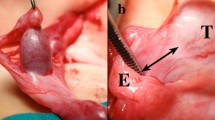Abstract
Normal testicular descent is achieved by a residuum of primitive embryonic mesenchyme which is retained through into the fetal period; this is the gubernaculum testis. It forms a medium into which the cremaster muscles and the processus vaginalis can develop in anticipation of testicular descent. At the time of descent the gubernacular mesenchyme dilates, largely due to the uptake of fluid by the interstitial hyaluronic acid. By this means the scrotal sac is dilated and, with concurrent growth of related structures, all under the overall influence of maternal and chorionic gonadotrophic (luteinising) hormones, stimulating the testicular interstitial cells of the fetal testis, testicular descent is permitted.
Failure to maintain the undifferentiated gubernacular mesenchyme, as by invasion of differentiating tissues, mechanically prevents the necessary growth to normal descent and may thus produce ectopic testes. Failure of the fetus to respond to luteinising hormones either by testicular interstitial cellular response, or the other tissues' response to normally produced testosterone, leads to an essentially hormonal failure of descent (cryptorchidism). Commonly, the failure to descend is no more than a premature birth, so separating the fetus from its source of luteinising hormone before the descent process is complete. The replacement of that antenatal stimulus of luteinising hormone at an early postnatal stage appears the logical treatment of cryptorchidism. However, if a proper scrotal formation has not occurred, then the indication is that the gubernaculum has not carried out its initial dilating function and probably the testis is deficient in its interstitial cell secreting potential.
Similar content being viewed by others
References
Baillie AH, Ferguson MM, Hart DM (1966) Developments in histochemistry. Academic Press, New York
Backhouse KM (1959) Testicular descent and ascent in mammals. Proc XV Internat Congr Zool, London, p 413
Backhouse KM (1964) The gubernaculum testis Hunteri: Testicular descent and maldescent. Ann R Coll Surg Engl 35:15
Black VH, Christensen AK (1969) Differentiation of interstitial cells and Sertoli cells in fetal guinea pig testes. Am J Anat 124:11
Fonkalsrud EW (1978) The undescended testis. Current problems in Surgery 15 (3). Year Book Medical Publishers Ic. Chicago London
Gier TH, Marion GB (1970) Development of the mammalian testis. In: Johnson AD, Gomes WR, Van Denmark L (eds) The testis, vol 1. Academic Press, New York
Giroud A (1958) La fonction spermatogenetique du testicle humain. Masson, Paris
Hadžiselimović F (1977) Cryptorchidism. Adv Anat Embryol Cell Biol 53:1
Holstein AF, Wartenberg H, Vossmeyer J (1971) Zur Cytologie der pränatalen Gonadenentwicklung beim Menschen. Anat Embryol (Berl) 135:43
Jost A (1961) The role of fetal hormones in prenatal development. Harvey lectures. ser 55. Academic Press, New York London
Witschi E (1948) Migration of the germ cells of human embryos from the yolk sac to the primitive gonadal folds. Contrib Embryol Carnegie Inst 32:67
Author information
Authors and Affiliations
Rights and permissions
About this article
Cite this article
Backhouse, K.M. Development and descent of the testis. Eur J Pediatr 139, 249–252 (1982). https://doi.org/10.1007/BF00442174
Issue Date:
DOI: https://doi.org/10.1007/BF00442174




